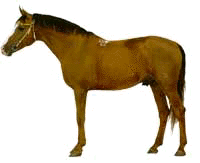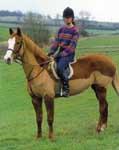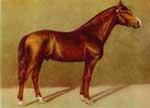| The Don |  |
One of Russia’s most renowned mounts.
Economical & undemanding general-purpose horse.
Good endurance racer.
The Don seems to be the most well-known of the Russian breeds. It became especially famous after the European Odyssey of the Don Cossacks in the 1810s during the Napoleonic wars. Millions of Cossacks, and other Russian cavalrymen, rode Dons. The Don was an ideal Cossack horse and it used to be in great demand by the Cossacks, who joined the Cossack force with their own horses. It was also favored by the regular Russian army, especially at war (not on the parade grounds), when one’s life was at stake. The Don is perhaps the most graphic example of what is generally meant by the Russian horse. A tough sturdy survivor, it has saved many a life both at war and in the steppe, when exposed to the most outrageous elements and wolves. It was also a good hunter in the tough Russian fields, especially in wolf hunting.
| Habitat The Dons come from the Don steppe, with extremely hot and often drafty summers and cold and snowey winters. One valuable feature of the place is the fact that after autumn rains grasses would normally yield ample growth that remained green under a thick layer of snow. Since time out of mind the nomads and Cossacks used it to support their animals in winter. They have practiced the so-called tebenevka. |
 |
Conformation
The Don is robust and sturdy, well boned and muscled. The Don is the most wide-bodied of the Russian riding horses, except for several local breeds such as Kazakh. This feature, which occurs with many steppe and forest breeds, is caused by the adaptation of the horse to the rigors of continental climates, their ability to live of rough foods and accumulate in their system reserves of fat that would last them through the frosty spells in winter and drafts in summer.
The Don's back and loins are relatively wide and straight. The croup is rounded and the quarters tend to slope away, the tail being accasionally low-set. The breast cage is well developed and long, with oval ribs. The belly is fairly spacious, but not bulging, which is indicative of a large capacity of alimentary organs and well developed belly muscles. The ribs are long and well-sprung. The shoulder is often short and straight, which limits the length of stride. The withers are for the most part average-sized, often low.
The Don’s head is clean, small to medium-sized, with a level or somewhat dished profile, wide in the forehead and properly set. The poll is often short. The neck is highly set and of medium length, there occur Dons with beautifully curved necks and short ewe necks.
The legs are boney and clean with well defined joints and tendons. The hinglegs have a tendecy to be sickle-hoched and, in the old types, the pelvic corner was so placed that it restricted the freedom of movement. The pasterns are of normal length and slope, although upring front pasterns are not uncommon. The hoofs are correct and hard.
When the retreating Europeans were crossing the Berezina River in December 1812, Cossak regiments on Don horses shocked the enemy by plunging into the icy water up and downstream and immediately attacking Napoleon's troops who had just crossed.
Average measurements of Dons
| Stallions | Mares | |
| Height | 162 | 160 |
| Body length | 164 | 164 |
| Chest girth | 187.5 | 187 |
| Bone below the knee | 20.6 | 20.2 |
 |
Colour Most of the Dons are chestnut, often with a beautiful golden sheen. There are some bay and brown horses. |
History
Since the 14th century Cossacks settled on the Don river, at first as fugitives from serfdom, and then as defenders of the Crown against the hordes of nomads who were sweeping through the southern Russian steppes. A Cossack’s survival depended on his horse.
This explains the immense attention historically paid by the Don Cossacks to horse breeding. In continuous skirmishes and raids Cossacks confronted light nomad horsemen, and so the Cossacks had to have, besides their mastery of all the steppe martial arts (see Jighitovka), equine companions that were more than a match to the mounts of their steppe opponents.
The Old Don
The early Don horse was a product of evolution, rather than cultured breeding. The initial stock for the Dons were the semi-wild horses of the Russian steppe. It is quite possible that Tarpans left their mark on the Don.
Cossacks would also bring from their raids horses of Oriental origin, such as Karabakh, Turkmenian, and Persian.
The early development produced a good steppe steed. It was a medium-sized, rangy, agile and brave horse of staggering endurance and vitality. It was again a product of the survival-of-the-fittest and primitive selection, so common with most of Russian breeds — thousands of horses were lost in raids through waterless and grassless steppes and deserts.
A product of the centuries, the steed came to be known as the Old Don horse, which laid the foundation for the current Don breed. In later centuries the Don breed was upgraded using Orlov and Orlov-Rostopchin sires, and yet later Thoroughbreds.
European exposure Europe has learned about the Don after Suvorov’s campaigns and the Russian campaign of Napoleon. The Don Cossacks mounted on their formidable Dons contributed enormously to the destruction of Napoleon’s multinational invasion of Russia.
Cossacks left behind in France not only martial reminiscences, but also some linguistic artifacts — the French word Bistro comes from the Russian bystro (quickly) reportedly cried out by Cossacks, those no-nonsense tough warriors, in Paris when they stormed into a local “watering hole” requiring drinks.
The war of 1812 revealed the overwhelming supremacy of the Don horses over the best equine breeds of Europe not only in terms of endurance, but in other terms as well. The Dons enabled Cossacks to cut into Napoleon’s lines, work havoc in the French supply communications, pursuit, and escape. The Cossacks outperformed and outmaneuvered European cavalry hands down.
When the retreating Europeans were crossing the Berezina River in December 1912, Cossack regiments on Don horses shocked the enemy by plunging into the icy water up and downstream and immediately attacking Napoleon’s troops who had just crossed.
Early cultured breeding
In the latter half of the 19th century Dons were in great demand. And so private Don breeders began to produce Dons as remounts for the entire Russian army. They bred for height, conformation, stamina, and impressive chestnut color with a golden sheen. As the Dons were gaining popularity abroad, more and more of them were exported, mostly via Hungary.
After 1920
The latest period in the history of the Don breed began in 1920, when what little remained of the stock after the First World War and the Civil War was carefully assembled at several military studs organized in 1921. Some Dons remained with the Cossack population. The stock was restored fairly quickly.
Endurance
Historically, the Dons have been renowned for their stunning stamina. Along with other Russian breeds, such as the Kabardins and Bashkirs, they surpassed the best European breeds.
In the last war Russian cavalry corps mounted on Dons and Budennys used to cover huge distances under most unfavorable weather conditions, sometimes unshod, and almost always without adequate food and rest.
 |
All the information and photographs for this section were kindly provided by Troika, the ultimate Russian horse resource online. For further information on Russian horses and horsemanship please click here |